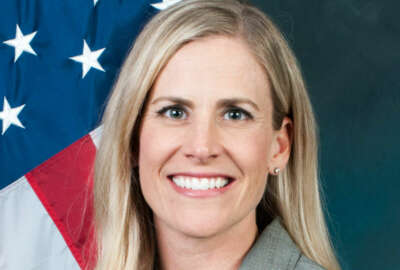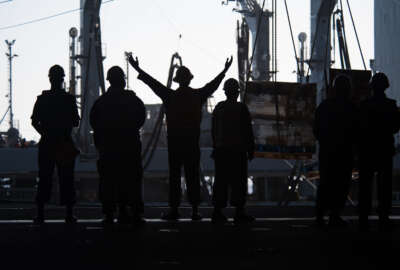
How the Navy keeps its guns ready to fire no matter where in the world they are
The Navy famously has a challenge in keeping its ships, ship shape and ready. Bolted to naval ships are the weapons systems that form a ship's purpose.
The Navy famously has a challenge in keeping its ships, ship shape and ready. Bolted to naval ships are the weapons systems that form a ship’s purpose. Naval Supply Systems Command has a special unit for that called Weapons Systems Support. At the Sea Air Space conference this week, the Federal Drive with Tom Temin caught up with Weapons Systems Support commander, Rear Admiral Kenneth Epps.
Interview transcript:
Kenneth Epps So we are an [echelon 3] command under the Naval Supply Systems Command, and our role is to provide program and supply support to all of our warfighting domains. Think aircraft, submarines, ships. We also do significant work for all of our allies and partners as well. And really, in lay speak, our role is to be the end to end supply chain integrators for the Navy to ensure that we are maximizing lethality to our warfighters through the supply chain. My command is responsible to the Department of the Navy in that regard.
Tom Temin Now, having visited Dahlgren, I’ve seen the testing going on —
Kenneth Epps At the Aegis Center, yes.
Tom Temin — and watched those things plunk down in the river. But Navy ships are deployed far away. And the weapons systems, specifically aboard, those are treated separately for purposes of program from, say, propulsion and logistics and other supply types of support.
Kenneth Epps Right. Yes.
Tom Temin What are some of the challenges of keeping those weapons going when they’re thousands of miles away?
Kenneth Epps The challenges are endless. I think the most important thing that we do is to ensure that all of our weapons systems have the endurance they need to be able to sustain in any kind of conflict that we get into. So there are some very complex algorithms that go into that. We can do that principally from the shore to support all of our forces that are at sea, under the waters and in the air. So it’s easy for us to do that, but it’s a very difficult and challenging supply chain that we have to manage that is truly global. And as you know, in the Navy, the key battle unit is the Carrier Strike group and the Amphibious Readiness group. And so our ability to support them from our command in Pennsylvania, is something we’ve been doing for many, many, many years. It’s challenging, but one that we have fairly mastered pretty well.
Tom Temin And I imagine that a lot of repair and maintenance has to happen aboard, that is to say. But is there ever a case where they sort of call you like you would call Triple A when you can’t change the tire yourself?
Kenneth Epps There are ways of doing that. We typically are going to have two ways of repairing stuff. So we have Navy organic capacity, Marine Corps capacity who can repair it. So think Marines and sailors who do this work. And then we are in significant partnership with our commercial entities. So think of all of our OEMs or original equipment manufacturers who build the planes, the ships, the submarines. And that partnership with them allows us that in an emergency, when 911 is dialed, we have the capacity to help out.
Tom Temin You could get there.
Kenneth Epps We can get there. We can get the thing there. In the worst case scenario, we can get a human there if we need to, but typically we can get the thing there.
Tom Temin Yes. And these weapon systems are pretty complex. They’re really subsystems. They are systems of systems in and of themselves mounted on something that takes them to the battle. And question is, how is the supply base looking? Because there’s probably a hundred suppliers or a thousand suppliers make up something that rotates and goes boom.
Kenneth Epps Yeah. So we have thousands of individual suppliers. But as you well know, the industry has really consolidated over the last many, many years. So we have, in many ways, we are sole source or single source on a majority of the product lines that we manage. So in that way it’s less challenging, because we have a certain number of players that we know to deal with. The challenge becomes as the forces of economics move about being able to keep industry at pace with our warfighting needs and making sure that sustainment is always a top priority for them. Oftentimes our manufacturers will build a new thing, we’ll send it out. And then sustainment previously, has sometimes been not of primacy. And what we’ve learned recently is that 95% of the life of any ship or aircraft or submarine is in a sustainment angle. So what do we do to support that? That’s where my team and the program officers come in.
Tom Temin And say, you’re talking about a gun that might be on a airplane or a cannon type of thing that might be on a ship. What is the relationship of the actual ordnance to the system? Because if the ordnance changes, does the system have to change and vice versa, is that all under weapon system support?
Kenneth Epps So that is not the moniker of a weapon. Don’t associate that with ordnance. We do manage ordnance in naval supply Systems command. Parent Command has an organization that does ammunition. But within my specific entity, when we say weapon system support, we mean the actual ship, aircraft, submarine and the attendant systems that are on board those platforms. That’s the weapon, not the the bullet.
Tom Temin No, understood. But if, say, there’s a metallurgical change in the bullet, so to speak. Or they have a different firing compound at the end that might affect the delivery system. So you have to talk to each other.
Kenneth Epps It could, yes, we do have to talk to each other. And it’s a very complex way of support between the fleet, the folks in the hardware systems commands who manage that, and then the role that we play as well.
Tom Temin And the given system has a long life. Ship has a long life. And so is there a mechanism to feedback for kind of continuous improvement between what you’re experiencing during tests or trials at sea or God forbid, actual combat, and back to that supplier as to what happened, and what they can do to make it better.
Kenneth Epps So, there is a continuous feedback loop. It is an eternal, it never stops. The feedback loop changes, because remember, the thing that was built 20 years ago has been modernized and updated over a subsequent number of years. So as the, let’s say, the ship, as an example, has modernized the things that have been put on there have changed. And so that, in some ways, a very different ship than we bought 20 years ago. So there’s a continuous feedback loop into the support mechanisms. My team at Naval Supply Systems Command Weapon Systems support the Program Office and in conjunction we do all the things necessary to update the support and to make sure it gets back to the ship so that they are ready to do what they have to do.
Tom Temin And during development of, say, a future new system where there’s nothing yet to support. What’s your involvement then?
Kenneth Epps So we are critical to that. So we are a cradle to grave sustainment enabler for all weapon systems. You look at some of the new unmanned aircraft that are coming out, as an example. And my team is there with the program offices discerning what the requirement is for this new weapon system and then determining with the manufacturer of the platform what needs to be bought in initially, and then what kind of support they would need over the 20, 30, 40 year lifespan to ensure that the resources that are required to properly sustain that weapon system are available initially, so that we can do our job and sustain it for its lifetime.
Tom Temin And the operation of these systems is down to the sailor. And it could be someone that is not high rank. So you must have a mechanism for, hey, what’s it like when you actually use this thing?
Kenneth Epps Yeah. So the rank in this way is really in material. The center of our universe is our sailors. In the sustainment world, I say the mechanics are really the center of our universe. And so the person who is turning the wrench, who is operating that equipment knows better than any Ph.D, who probably designed it. And certainly knows better than my team, who are away from it and know that in the abstract what we have to do to support it we can do. But really, those sailors, wonderful men and women, wonderfully talented, wonderfully trained, they are really that first step to allowing us to know exactly if that thing is operating as it’s supposed to.
Tom Temin And being based in Pennsylvania, Mechanicsburg.
Kenneth Epps My headquarters is in Philadelphia, but I have an office in Mechanicsburg, in Norfolk, and the NAVSUP properties in Mechanicsburg.
Tom Temin And do you ever get out of Mechanicsburg, out of Philadelphia, and maybe land on deck and say, How’s it going?
Kenneth Epps So I spend as the commander of NAVSUP WSS, I spent probably a majority of my time traveling seeing key partners, both on the commercial side, and then going out to see the fleet commander. So yes, I am constantly doing pulse checks to ensure that what we think we’re providing, and what we’re delivering to that sailor I talked about, that those two, there’s no gap between them.
Tom Temin You got to make sure the paint holds up.
Kenneth Epps The paint holds up, too. That’s super important.
Copyright © 2025 Federal News Network. All rights reserved. This website is not intended for users located within the European Economic Area.
Tom Temin is host of the Federal Drive and has been providing insight on federal technology and management issues for more than 30 years.
Follow @tteminWFED





